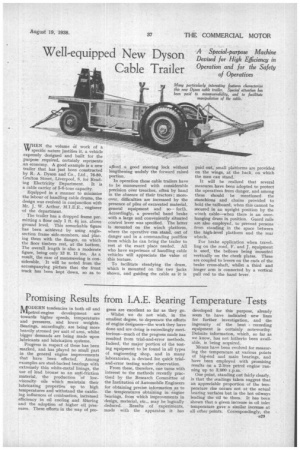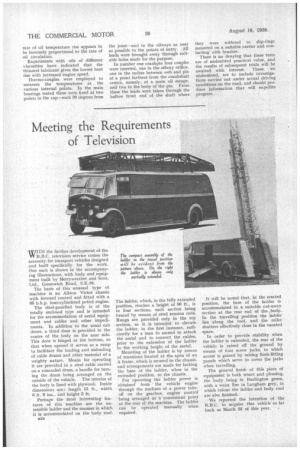Promising Results
Page 33

Page 34

If you've noticed an error in this article please click here to report it so we can fix it.
from I.A.E. Bearing Temperature Tests
AODERN tendencies in both oil and iVipetrol-engine development are towards higher speeds, temperatures and pressures, and lower weights. Bearings, accordingly, are being more heavily stressed per unit of area, whilst bigger• demands are being made upon lubricants and lubrication systems.
Progress in respect of these has been marked, and has played no small part in the general engine improvements that have been effected. Among examples are steel-backed bearings with extremely thin white-metal linings, the use of lead bronze as an anti-friction material, the production of lowviscosity oils which maintain their lubricating properties up to high temperatures and withstand the oxidizing influences of combustion, increseed efficiency in oil cooling and filtering and the adoption of higher oil pressures. These efforts in the way of pro
gress are excellent so far as they go.
• Whilst we do not wish, in the smallest degree, to deprecate the efforts of engine designers—the work they have done and are doing is exceedingly meritorious—much of the progress made has resulted from trial-and-error methods. Indeed, the major portion of the testing equipment to be found in all types of engineering shop, and in many laboratories, is devised for quick trialand-error testing under observation.
From these, therefore, one turns with interest to the methods recently practised by the Research Committee of the Institution of Automobile Engineers for obtaining precise information as to the temperatures obtaining in engine bearings, from which improvements in design, material, etc., may be logically deduced. Results of experiments, made with the apparatus it has developed for this purpose, already seem to have indicated new lines for further investigation, and the ingenuity of the heat recording equipment is certainly noteworthy. Definite information, which, so far as we know, has not hitherto been available, is being acquired.
Means have been evolved for measuring the temperature at various points of big-end and main bearings, and have been employed with promising results on a 2-litre petrol engine running up to 3,000 r.p.m.
One point, standing out fairly clearly, is that the readings taken suggest that an appreciable proportion of the temperature rise occurs not at the actual bearing surfaces but in the hot oilways leading the oil to them. It has been shown that a given increase in oil inlet temperature gave a similar increase at all other points. Correspondingly, the
rate of oil temperature rise appears to be inversely proportional to the rate of oil circulation.
Experiments with oils of different viscosities have indicated that the thinnest lubricant gives the lowest heat rise with increased engine speed.
'Thermo-couples were employed to measure the temperaturesat the various internal points. In the main hearings tested these were fixed at two points in the cap—each 30 degrees from the joint—and in the oilways as near as possible to the points of entry. All leads were brought away through suitable holes made for the purpose.
In number one crankpin four couples were inserted, one in the oilway orifice, one in the radius between web and pin at a point farthest from the crankshaft centre, namely, at a main oil escape, and two in the body of the pin. From these the leads were taken through the hollow front end of the shaft where they were soldered to slip-rings mounted on a suitable carrier and contacting with brushes.
There is no denying that these tests are of undoubted practical value, and the results of subsequent trials will be awaited with interest. These, we understand, are to include investigations carried out under actual driving conditions on the road, and should produce information that will expedite progress.




















































































